Rural scenery
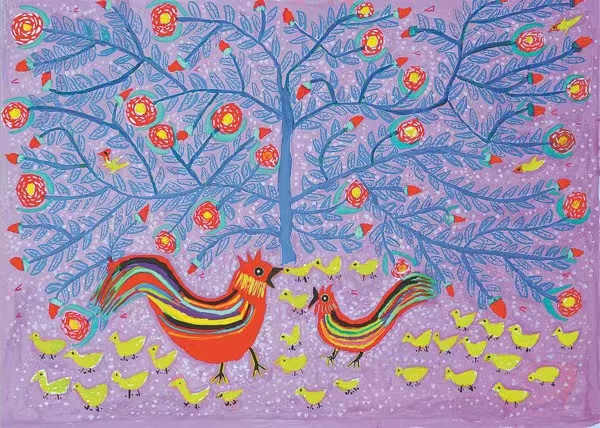
Happy Family. [Photo provided to China Daily]
In the main cultural venue of Jiaxing city's Xiuzhou district, Zhejiang province, a few elderly women are using their imagination and some bright colors to paint the idyllic scenes of life in Jiangnan, or "south of the Yangtze River". They are members of a farmer-painter group known as the "Ten Sisters", formed in 2009. The group has 12 rural residents, the oldest of whom is 76 years old and the youngest 61.
"They all hail from Hexin village (in Jiaxing) and took painting lessons at the same time," says Zhu Qinhua, an instructor from the district's cultural venue. "Ten here is more a reference to 'perfection' rather than a specific number, hence the name."
In fact, the group didn't start out as painters. As dancing enthusiasts, the farmers went to the district's cultural venue to participate in activities. In 2009, they were asked whether they would like to learn painting.
"At first, we all thought we couldn't make it. I, for one, was illiterate,"Dong Aina, one of the members, recalls." But with the guidance and encouragement from our instructors, I grew more and more at ease with painting."
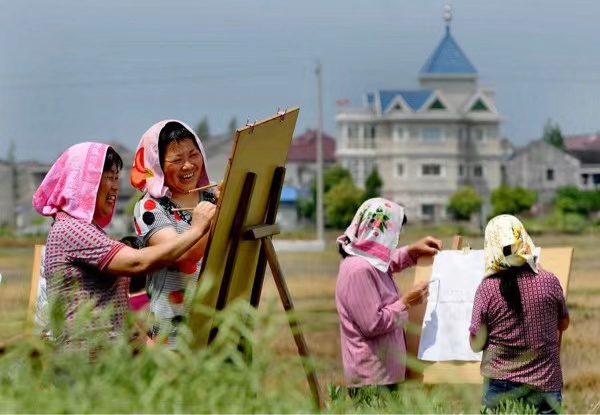
A farmer-painter group known as the "Ten Sisters" has 12 rural residents, the oldest of whom is 76 years old and the youngest 61. [Photo provided to China Daily]
For years, they discuss with instructors from the Xiuzhou district cultural venue about their work in the village on Wednesdays. They exchange ideas about composition and coloring and their experience of painting. This has become routine for the elderly women and their instructors. To create a piece of work, they must first make a sample on A4 paper, tell the instructor about the ideas, and then perfect it according to the instructor's advice. After that, they need to scale up, enrich the details, and color it until the creation is complete, according to the "Ten Sisters".
"Incredible" is the word most uttered by 67-year-old Dong. "For various reasons, I wasn't able to go to school, and I don't even know how to write my own name, but now I'm called a 'painter', and I'm just very happy about that."
She recalls the first time she got down to painting: "My hands were shaking badly and when the instructor asked me to paint a fish, I was so nervous that I painted four legs on it!"
After their training, the paintings are no longer "childish", one of the instructor's says.
"This painting seems to be flat, but if you look closely, you can see that it actually shows a three-dimensional scene," pointing at a painting entitled Fairy Embroidery, the instructor says. "None of them have received professional training, it is not easy to have such an imagination." That aside, the group has worked hard.
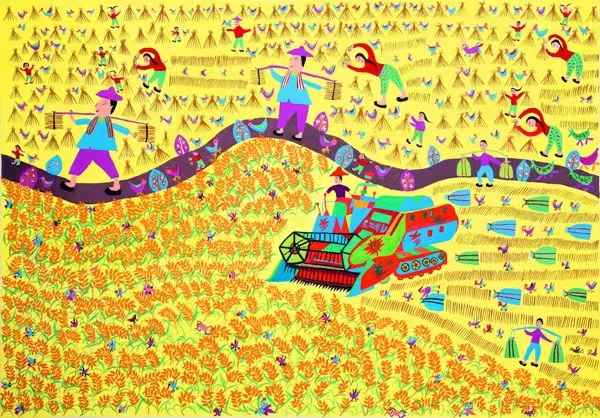
Autumn Harvest. [Photo provided to China Daily]
Jiang Sanna, the oldest member of the group and the maker of Fairy Embroidery, gets up at 4 am every day to practice painting. The support from her son and grandson is indispensable, she says. They have installed a 100-watt light bulb for her because of her weak eyesight. Many times, to provide inspiration for her painting, Jiang's grandson walks long distances to neighboring villages to take pictures of natural scenery for her reference. In the past years, over 50 paintings by the "Ten Sisters" have won awards at national and provincial competitions and a number of exhibitions have been organized.
Compared to other genres, farmers painting in China is relatively new. Born from folk traditions, it took roots in rural areas in the 1950s after the founding of the People's Republic of China in 1949, and generally refers to works created by amateur artists who are farmers, herders or fishermen.
Drawing on rural life that these farmer-painters are familiar with, their paintings invariably lend an authentic flavor and vivid color to the social changes that have taken place in the countryside over the past six decades or so.
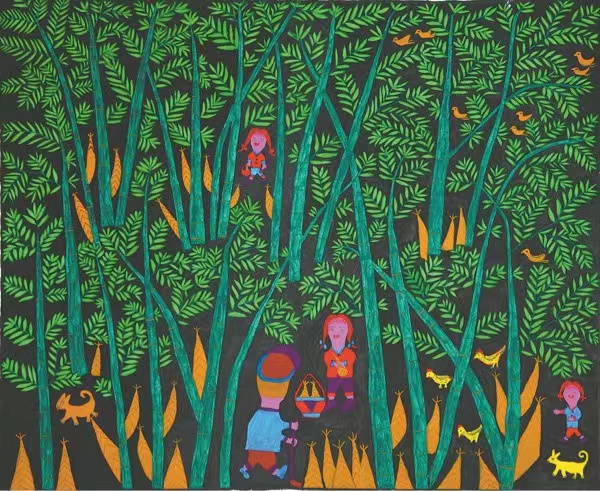
Digging Bamboo Shoots. [Photo provided to China Daily]
The paintings of this group are no exception. The transformation and development of China's new countryside in recent years can be clearly detected in them.
"At the beginning, we painted simple scenes such as raising chickens and ducks, and catching fish, but later, our paintings started to include subjects such as sewage treatment, river-cleaning and centralized garbage treatment," says Dong Ai'e, another member. "Many years later, people may well rely on our paintings to recall the changes in the rural areas."
Farmer-painters like "Ten Sisters" are not rare in Jiaxing, or even in Zhejiang.
Miao Huixin, a leading farmer-painter from the city, was named one of 10 "outstanding Asian artists" by Time magazine in 1998, and as a national "excellent folk painter" by the Seventh China Art Festival in Jiaxing in 2004. He has also held solo exhibitions in the United States and Japan.
Over the years, local governments have put in effort to promote painting among farmers and enrich their cultural life. In as early as 2001, the China Farmers Art Center was already established in Xiuzhou district, and a festival featuring farmers paintings has been held every two to three years since then. Studios have been set up for farmer-painters to have a fixed place for their hobby. In 2019, Xiuzhou was named a "hometown of Chinese folk culture and art" by the Ministry of Culture and Tourism.
Farmers painting has also entered the market, and related products such as silk scarves, hats and shoes are bringing economic benefits to locals.
If you have any problems with this article, please contact us at app@chinadaily.com.cn and we'll immediately get back to you.


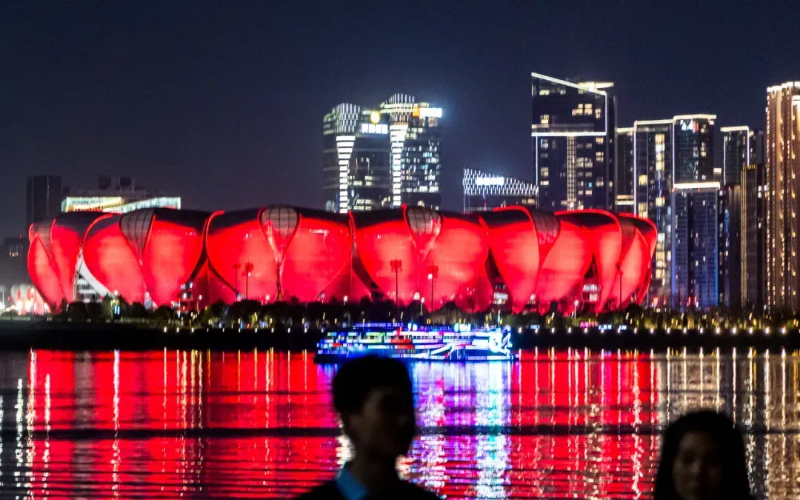

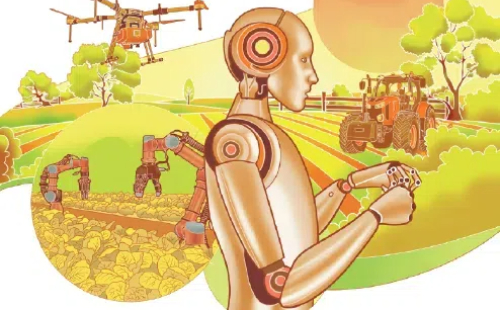
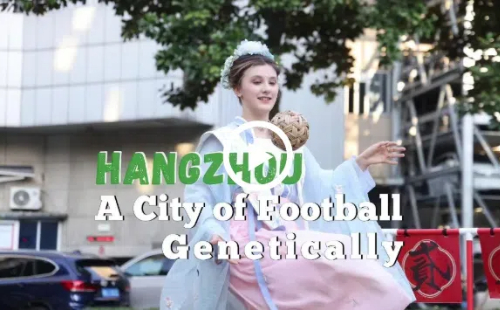 play
play